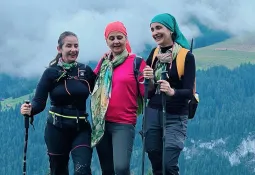- Home
- Adventure Tour
- Everest Dudhkoshi Cultural Trail : A Gateway to Nepal's Himalayan Grandeur

Everest Dudhkoshi Cultural Trail : A Gateway to Nepal's Himalayan Grandeur
Nestled within the heart of Nepal, the "Everest Dudhkoshi Cultural Trail" is heralded as the new frontier in tourism, promising to redefine the way travelers experience the majesty of the Himalayas. Beginning its ascent from Silgudi Danda in the Dhudhkoshi rural municipality, this trail offers vistas of not just the world's highest peak, Sagarmatha (Mount Everest), but more than a dozen other towering summits.
The journey along this trail transcends mere sightseeing; it's an invitation to experience a heavenly realm. Yet, beyond its awe-inspiring landscapes, the trail holds the promise of unlocking economic prosperity. As it winds through forests blossoming with various flora, including the vibrant rhododendrons, within a four-hour trek from the Silgudi Danda, one reaches the mesmerizing Syabru dance of the Sherpa community.

Linked intricately with Sherpa culture, this trail leads to "Kudham View Point." Here, the municipality has made strides in creating resting spaces for nighttime stays. Standing tall at 3,168 meters, this viewpoint offers an effortless glimpse of the Everest region's highest peaks.
Ascending further to an altitude of 8,148 meters, one can witness Sagarmatha and an array of other peaks like Batang (5,077m), Choyma (4,713m), Vigphera (6,600m), Numburchuli (6,960m), Karlung (6,511m), Kongde Ri (6,187m), and more. The trail extends to showcase 27 such majestic Himalayan peaks, an unparalleled spectacle.
Descending from this height, one reaches Lukla Airport, catching panoramic views of Namche Bazaar. Another day's journey from Kudham leads to Yotelmeme, where the municipality has developed accommodation and a route along the Dudhkoshi River towards Sagarmatha.

Further exploration around Dhadinga, Danda Gaun, and Magar Khaling presents the Rai Museum, offering a glimpse into Rai culture and opportunities for folk dances and cultural immersion.
With the initiative jointly taken by the Trekking Agencies' Association of Nepal (TAAN) and the Dhudhkoshi rural municipality, last year marked an agreement for the operation of the "Everest Dudhkoshi Cultural Trail." TAAN's groundwork and mapping have paved the way for this trail's operation.
In recent times, Nepal has emerged as a premier destination for trekking worldwide. Travelers are increasingly drawn to Nepal, recognizing the potential for trekking experiences and the intrinsic value of these journeys. Roughly 30% to 40% of tourists in Nepal engage in trekking activities.
The municipality's efforts in fostering homestay tourism, culinary training, campsite management, and even establishing the "Rock Climbing Center" in Mahabhir aim to ease the development of tourism. Kami Rita Sherpa, a world-renowned Mount Everest summiter, envisions seamless tourism development to showcase the natural beauty to both domestic and international tourists. According to him, "Tourism flourishes not just by showcasing what's known but by revealing the new."

The months from October to February promise enthralling views, attracting adventurous tourists. The regions around Sagarmatha Base Camp, Annapurna, Manaslu, and Kanchanjunga become prime destinations for trekking enthusiasts. Nepal hosts over two million domestic and international tourists annually, a number steadily rising. Recent times have witnessed a surge in both domestic and international trekkers.
The "Everest Dudhkoshi Cultural Trail" represents not just a journey through stunning landscapes but an odyssey into the heart of Nepalese culture and hospitality. As tourism continues to flourish, Nepal stands as an epitome of the perfect amalgamation of natural grandeur and cultural richness.













Comment / Rely From